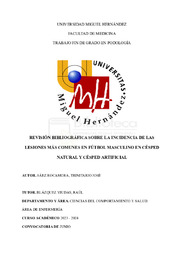Please use this identifier to cite or link to this item:
https://hdl.handle.net/11000/33401Full metadata record
| DC Field | Value | Language |
|---|---|---|
| dc.contributor.advisor | Blázquez Viudas, Raúl | - |
| dc.contributor.author | Sáez Rocamora, Trinitario José | - |
| dc.contributor.other | Departamentos de la UMH::Ciencias del Comportamiento y salud | es_ES |
| dc.date.accessioned | 2024-10-04T07:33:49Z | - |
| dc.date.available | 2024-10-04T07:33:49Z | - |
| dc.date.created | 2024-05-31 | - |
| dc.identifier.uri | https://hdl.handle.net/11000/33401 | - |
| dc.description.abstract | INTRODUCCIÓN: El fútbol ha evolucionado con la creciente adopción de césped artificial en los campos de juego, lo que ha contribuido a disminuir lesiones y mejorar la experiencia deportiva. Sin embargo, la selección apropiada del calzado es crucial para minimizar el riesgo de lesiones. Las áreas del cuerpo más propensas a sufrir lesiones, como la rodilla y el tobillo en jugadores masculinos, pueden variar según la edad. Comprender cómo la superficie de juego y las características individuales afectan a las lesiones puede ser clave para desarrollar estrategias efectivas de prevención y tratamiento, además de mejorar el rendimiento deportivo. OBJETIVO: El objetivo de esta investigación bibliográfica fue analizar y comparar las lesiones más comunes asociadas con el fútbol masculino en césped natural y artificial. MATERIAL Y MÉTODOS: Se llevó a cabo una revisión bibliográfica basada en evidencia científica sobre las lesiones sufridas por futbolistas masculinos, utilizando buscadores como PubMed y Scopus. Los artículos finalmente seleccionados fueron aquellos que cumplen con los criterios definidos para su inclusión y exclusión en la revisión. CONCLUSIÓN: A pesar del interés creciente en la relación entre el tipo de césped y las lesiones en futbolistas masculinos, esta revisión bibliográfica ha destacado la falta de consenso en la literatura científica. La mayoría de los estudios han sugerido una mayor incidencia de lesiones en césped artificial, pero uno indica lo contrario. Se ha enfatizado la importancia del diseño de los tacos, factores individuales y condiciones ambientales como elementos clave. Aunque hay una tendencia en las lesiones de rodilla y tobillo, se han requierido más investigaciones para comprender mejor las lesiones específicas asociadas con cada tipo de superficie, lo que ha facilitado el desarrollo de estrategias de prevención más efectivas. | es_ES |
| dc.description.abstract | INTRODUCTION: Soccer has evolved with the increasing adoption of artificial grass on playing fields, which has contributed to reducing injuries and improving the sporting experience. However, proper footwear selection is crucial to minimize the risk of injury. The areas of the body most prone to injury, such as the knee and ankle in male players, can vary depending on age. Understanding how the playing surface and individual characteristics affect injuries can be key to developing effective prevention and treatment strategies, as well as improving sports performance. OBJECTIVE: The objective of this bibliographic research is to analyze and compare the most common injuries associated with men's soccer on natural and artificial grass. MATERIAL AND METHODS: A bibliographic research is carried out based on scientific evidence on injuries suffered by male soccer players, using search engines such as PubMed and Scopus. The articles finally selected are those that meet the defined criteria for inclusion and exclusion in the study. CONCLUSION: Despite the growing interest in the relationship between the playing surface and injuries in male soccer players, this literature review highlights the lack of consensus in the scientific literature. Most studies suggest a higher incidence of injuries on artificial turf, but one indicates the opposite. This highlights the need for more contextualized investigations. The importance of stud design, individual factors, and environmental conditions are emphasized as key elements. Although there is a trend in knee and ankle injuries, more research is required to better understand the specific injuries associated with each type of surface, which would facilitate the development of more effective prevention strategies. | es_ES |
| dc.format | application/pdf | es_ES |
| dc.format.extent | 28 | es_ES |
| dc.language.iso | spa | es_ES |
| dc.publisher | Universidad Miguel Hernández | es_ES |
| dc.rights | info:eu-repo/semantics/openAccess | es_ES |
| dc.rights | Attribution-NonCommercial-NoDerivatives 4.0 Internacional | * |
| dc.rights.uri | http://creativecommons.org/licenses/by-nc-nd/4.0/ | * |
| dc.subject | Lesiones | es_ES |
| dc.subject | fútbol | es_ES |
| dc.subject | césped natural | es_ES |
| dc.subject | césped artificial | es_ES |
| dc.subject.other | CDU::6 - Ciencias aplicadas | es_ES |
| dc.title | Revisión bibliográfica sobre la incidencia de las lesiones más comunes en fútbol masculino en césped natural y césped artificial | es_ES |
| dc.type | info:eu-repo/semantics/bachelorThesis | es_ES |

View/Open:
REVISIÓN BIBLIOGRÁFICA SOBRE LA INCIDENCIA DE LAS LESIONES MÁS COMUNES EN FÚTBOL MASCULINO EN CÉSPED NATURAL Y CÉSPED ARTIFICIAL.pdf
7,62 MB
Adobe PDF
Share:
.png)
